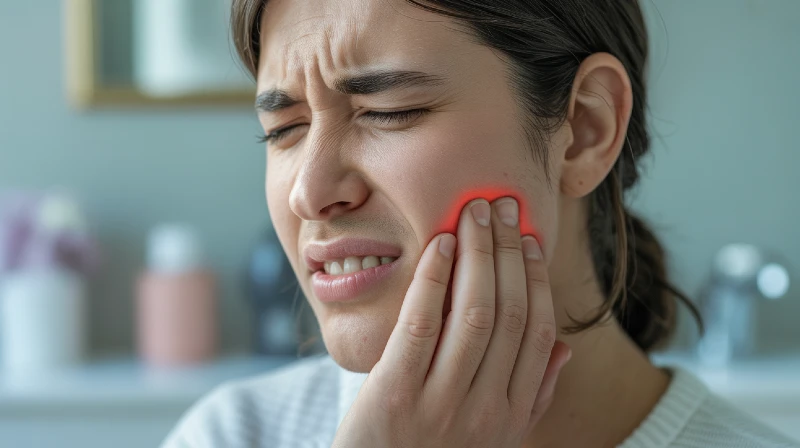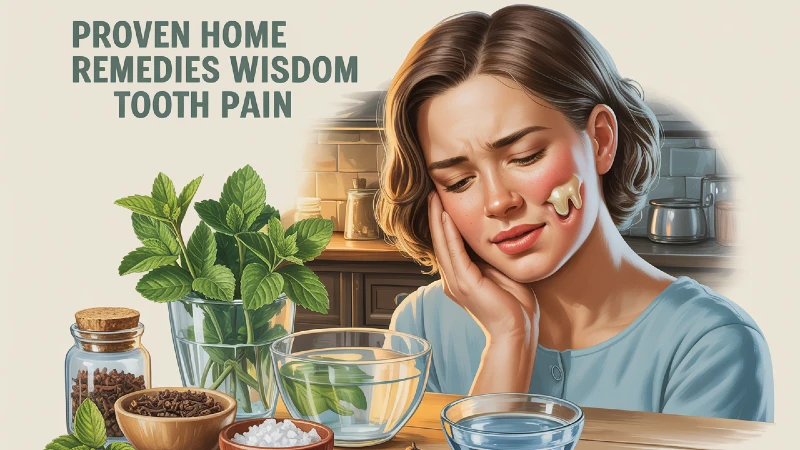Home Treatment for Wisdom Tooth Pain
Experiencing wisdom tooth pain can be both uncomfortable and disruptive, making it difficult to eat, speak, or focus on daily tasks. But before you rush to the dentist, know that there are several effective home remedies that can help ease the pain quickly and naturally.
In this guide, you’ll discover science-backed strategies and soothing treatments you can try at home to relieve wisdom tooth discomfort. Whether you’re dealing with swelling, inflammation, or throbbing aches, these methods offer temporary relief while you prepare for a dental consultation.

Understanding Wisdom Tooth Pain: Causes and Complications
Wisdom teeth, also known as third molars, are the last set of permanent teeth to develop, typically appearing between the ages of 17 and 25. In evolutionary terms, these molars were once essential for our ancestors, who had larger jaws and relied on a coarse diet that wore down teeth faster. However, modern diets and smaller jaw structures have rendered wisdom teeth less functional—and often problematic.
For some people, wisdom teeth erupt without any complications and align naturally with the rest of the teeth. But for a significant portion of the population, limited jaw space and changes in dental alignment create challenges, leading to a range of painful conditions:
🔹 Impaction
An impacted wisdom tooth is one that fails to fully emerge through the gums due to being blocked by bone, soft tissue, or other teeth. It may be:
Mesioangular (angled forward)
Vertical (upright but trapped)
Distoangular (angled backward)
Horizontal (completely sideways)
Impaction can cause pressure, swelling, pain, and even damage to neighboring teeth or jawbone. It may also lead to cyst formation or infection if not addressed promptly.
🔹 Partial Eruption
In some cases, the wisdom tooth breaks through the gum only partially, creating a flap of gum tissue that can trap food particles and bacteria. This condition often leads to discomfort and makes cleaning the area difficult, increasing the risk of localized infection.
A partially erupted wisdom tooth is particularly vulnerable to pericoronitis, a painful inflammatory condition that may cause swelling, difficulty opening the mouth (trismus), and even a fever.
🔹 Overcrowding
Wisdom teeth can exert pressure on adjacent teeth as they try to erupt, especially in an already crowded mouth. This can result in:
Shifting or misalignment of the existing teeth
Increased risk of orthodontic relapse (undoing braces work)
Bite problems or jaw pain due to changes in dental arch structure
Overcrowding is not only a cosmetic concern—it can also affect chewing function and oral hygiene, increasing the risk of decay.
🔹 Pericoronitis
Pericoronitis is the inflammation and possible infection of the gum tissue surrounding a partially erupted wisdom tooth. It’s most common in lower molars and is caused by trapped food debris, bacteria, or trauma from biting down on the inflamed gum.
Symptoms include:
Redness and swelling
Foul taste or odor
Difficulty chewing or opening the jaw
Swollen lymph nodes and sometimes fever
If left untreated, pericoronitis can spread to other areas of the mouth or jaw, requiring antibiotic treatment or even surgical intervention.
Why It Matters
If any of these conditions persist or worsen, surgical extraction of the wisdom tooth is often the recommended course of action. Early evaluation by a dental professional (often via panoramic X-rays) can help identify potential problems before they escalate.

Symptoms of Wisdom Tooth Pain: What to Watch For
Recognizing the signs of wisdom tooth pain early can make a significant difference in treatment and comfort. Whether the pain is mild and intermittent or sharp and persistent, identifying the source allows for timely home care—or a prompt visit to the dentist.
Here are the most common symptoms associated with erupting or impacted wisdom teeth:
🔸 Throbbing or Radiating Pain
Pain is often localized at the back of the mouth, near the jawline or behind the molars. It may begin as a dull ache and intensify over time, especially when chewing. In some cases, the pain can radiate to the jaw, ear, or neck, making it hard to pinpoint the exact source.
🔸 Swelling and Tenderness
Swelling is a natural response to inflammation. You may notice:
Puffiness in the cheeks or jaw
Tenderness when touching the area
Visible enlargement of the gums near the erupting tooth
In severe cases, swelling can even impact facial symmetry and limit mouth movement.
🔸 Difficulty Opening the Mouth (Trismus)
Limited jaw mobility, or trismus, can make it painful or physically difficult to open the mouth fully. This often occurs with pericoronitis or impaction, especially if inflammation is putting pressure on surrounding muscles and tissues.
🔸 Bad Breath or Foul Taste
An unpleasant odor or taste may develop due to:
Trapped food particles around a partially erupted tooth
Bacterial buildup and poor drainage in the area
The beginning of an infection or abscess
These symptoms often persist despite brushing or using mouthwash and may indicate the presence of pus or active infection.
🔸 Red, Swollen, or Bleeding Gums
Gum tissue around the erupting wisdom tooth may become:
Bright red or darkened in color
Inflamed or tender to the touch
Prone to bleeding when brushing or eating
This is particularly common when a tooth is partially erupted and creating a gum flap (operculum), which is difficult to clean and highly prone to irritation.
⚠️ Other Possible Symptoms
In more advanced cases, you might also experience:
Fever or chills, suggesting systemic infection
Enlarged lymph nodes under the jaw or in the neck
Headaches or jaw tension from clenching in response to pain
Being aware of these symptoms not only helps in choosing the right home remedies but also signals when professional dental care is urgently needed.

Why Home Treatments Can Be Effective for Wisdom Tooth Pain
While a dentist should ultimately evaluate persistent or severe wisdom tooth pain, home remedies can offer meaningful relief—especially when symptoms arise unexpectedly or during travel, weekends, or after hours. These treatments are not a replacement for professional care, but they serve as powerful short-term solutions for managing discomfort and preventing complications.
🔹 Targeting the Root Causes
Most home remedies focus on three core goals:
1. Reducing Inflammation
Swelling around a wisdom tooth—especially if it’s impacted or partially erupted—can place pressure on nerves and soft tissues, intensifying the pain. Anti-inflammatory approaches (like cold compresses, saltwater rinses, or turmeric paste) help calm this response and restore comfort.
2. Numbing the Pain
Natural analgesics such as clove oil or over-the-counter medications like ibuprofen help block pain signals and improve quality of life while waiting for professional treatment. These methods are especially helpful for nighttime relief and restoring sleep.
3. Preventing Infection
One of the biggest risks with erupting or partially erupted wisdom teeth is the accumulation of bacteria, food particles, and debris. Antiseptic rinses (like saltwater or herbal teas), antimicrobial agents (such as garlic or onion), and good oral hygiene can reduce bacterial buildup and minimize the risk of infections like pericoronitis or abscesses.
🔸 When Home Remedies Are Most Useful
Home treatments work best in the following scenarios:
Early-stage pain that’s mild to moderate in intensity
Intermittent discomfort caused by gum irritation or pressure
Delays in dental appointments due to scheduling, cost, or availability
As complementary support after professional evaluation (e.g., before or after tooth extraction)
🛑 Important Reminder
Even if symptoms temporarily subside, home remedies are not a cure for structural issues like impaction or overcrowding. If pain persists for more than 72 hours, worsens, or is accompanied by signs of infection (fever, swelling, pus), you should seek dental attention immediately.
Proven Home Remedies for Wisdom Tooth Pain
When wisdom tooth pain strikes, the right home remedies can offer quick, natural relief—especially while you wait for a dental appointment. These methods work by reducing inflammation, numbing pain, and minimizing the risk of infection. Below is a list of trusted, effective remedies that are easy to apply with items commonly found at home.

✅ 1. Saltwater Gargle
Why it works: Salt is a natural antiseptic. Rinsing with saltwater reduces bacteria in the mouth, helps flush out debris from hard-to-reach areas, and soothes irritated gum tissue.
How to use:
Dissolve 1 teaspoon of salt in 1 cup of warm water.
Swish the solution in your mouth for at least 30 seconds.
Spit it out and avoid eating or drinking for 15–20 minutes afterward.
Repeat 2–3 times a day, especially after meals.
✅ 2. Cold Compress
Why it works: Applying ice reduces inflammation by constricting blood vessels. It also acts as a natural anesthetic, helping numb the area and relieve throbbing pain.
How to use:
Wrap a few ice cubes or a cold pack in a clean cloth.
Hold it against the outside of your cheek (near the affected area) for 15–20 minutes.
Take a 10-minute break before reapplying.
Use every few hours as needed.
✅ 3. Clove Oil Application
Why it works: Clove oil contains eugenol, a natural anesthetic and antibacterial compound known for relieving dental pain.
How to use:
Soak a small cotton ball or swab in clove oil (dilute with a carrier oil if needed).
Gently press it onto the affected gum for 5–10 minutes.
Do not swallow the oil.
Repeat 2–3 times per day.
🔍 Tip: If you don’t have clove oil, you can chew a whole clove near the painful area to release its natural oils.
✅ 4. Over-the-Counter Pain Relievers
Why it works: Medications like ibuprofen (Advil) or acetaminophen (Tylenol) reduce pain and inflammation systemically.
How to use:
Take as directed on the packaging.
Do not exceed the recommended dose.
Avoid using for more than a few days without consulting a healthcare provider.
📌 Note: Ibuprofen is particularly effective because it also targets inflammation.
✅ 5. Herbal Tea Rinses (Chamomile & Peppermint)
Why it works: Chamomile reduces inflammation, while peppermint provides a cooling, numbing effect that soothes sore gums.
How to use:
Brew a strong cup of chamomile or peppermint tea.
Let it cool to room temperature or refrigerate for a cold rinse.
Swish the tea gently around your mouth and spit out.
Repeat 2–3 times daily.
✅ 6. Aloe Vera Gel
Why it works: Aloe vera is known for its anti-inflammatory and antibacterial properties. It can reduce swelling and help fight oral bacteria.
How to use:
Use 100% pure aloe vera gel (no added fragrances or chemicals).
Apply a small amount directly to the irritated gums.
Let it sit for 15–20 minutes.
Rinse your mouth with lukewarm water afterward.
Apply up to 3 times per day.
✅ 7. Turmeric Paste
Why it works: Turmeric contains curcumin, a natural anti-inflammatory and antioxidant that helps reduce gum irritation and pain.
How to use:
Mix 1 teaspoon of turmeric powder with a few drops of water or coconut oil to form a thick paste.
Apply directly to the swollen or painful area using clean fingers or a cotton swab.
Leave on for 10–15 minutes, then rinse thoroughly.
Use once or twice daily.
🔬 Advanced Home Remedies for More Persistent Pain
These natural treatments may require a little more preparation but are powerful tools for stubborn pain and minor infection prevention.
✅ 8. Garlic Paste
Why it works: Garlic contains allicin, a compound with potent antibacterial and anti-inflammatory properties. It may also offer mild numbing effects.
How to use:
Crush a fresh garlic clove into a paste to release the oils.
Apply the paste directly onto the gum near the affected wisdom tooth.
Leave it on for a few minutes, then rinse with warm water.
Use once or twice per day.
✅ 9. Ginger and Cayenne Pepper Paste
Why it works: Ginger reduces swelling, and cayenne contains capsaicin, a natural pain reliever that blocks pain signals.
How to use:
Mix equal parts ginger powder and cayenne powder with enough water to form a paste.
Apply to the sore area with a cotton swab.
Leave for 5–10 minutes and rinse thoroughly.
Use with caution, especially if you have sensitive gums.
⚠️ Note: This remedy may cause a tingling or burning sensation. Discontinue if discomfort increases.
✅ 10. Onion Chewing
Why it works: Onions contain antimicrobial compounds that kill bacteria and reduce inflammation. They also stimulate saliva, which aids in natural cleaning.
How to use:
Cut a small piece of raw white or red onion.
Place it on the affected side of the mouth and chew gently for several minutes.
Rinse with warm water afterward to eliminate odor.
Repeat 2–3 times per day as needed.
Preventive Measures for Wisdom Tooth Pain
While home remedies can offer relief, the best strategy is prevention. Since wisdom tooth pain often stems from inflammation, infection, or impaction, proactive oral care and early monitoring are essential to reduce your risk.
🪥 Key Practices for Prevention:
Brush thoroughly twice a day using a soft-bristled toothbrush, paying special attention to the back of the mouth where wisdom teeth emerge.
Floss daily to remove food particles and plaque buildup between teeth and around partially erupted molars.
Use an antimicrobial or fluoride mouthwash to reduce bacterial load, strengthen enamel, and soothe inflamed gums.
Avoid sugary and sticky foods that can easily get trapped in gum flaps over erupting wisdom teeth.
Drink plenty of water, especially after meals, to help wash away debris and support saliva production.
Schedule regular dental check-ups, including X-rays if you’re between 17 and 25 or experiencing discomfort. Early detection of alignment issues or impaction can prevent complications down the road.
🦷 When to See a Dentist
While home care can provide temporary relief, certain symptoms indicate that professional dental intervention is necessary. Don’t ignore these warning signs:
🚨 Seek immediate care if you experience:
Pain lasting more than three consecutive days
Signs of infection: fever, pus, bad breath that won’t go away, or red and swollen gums
Facial swelling that worsens or spreads
Difficulty swallowing or breathing, which may indicate a serious infection
Jaw stiffness or trouble opening your mouth fully (trismus)
A visible abscess or swelling around the gum
In these cases, a dentist may prescribe antibiotics, recommend an oral surgeon, or schedule a surgical extraction depending on the severity.
❓ Frequently Asked Questions (FAQs)
How long can I use home remedies for wisdom tooth pain?
Home remedies are safe for short-term use, generally up to three days. If symptoms persist or worsen, see a dentist to rule out infection or impaction.
Can I use essential oils directly on my gums?
No. Essential oils like clove or tea tree should always be diluted with a carrier oil (e.g., coconut or olive oil) before applying to oral tissues. Undiluted oils can cause irritation or chemical burns.
Are over-the-counter pain relievers safe for long-term use?
Painkillers such as ibuprofen or acetaminophen are safe when taken as directed, but should not be used for more than a few days without medical supervision. Long-term use may lead to side effects or mask an underlying issue.
Do all wisdom teeth need to be removed?
No, not always. Some wisdom teeth erupt without issue and don’t require extraction. However, regular dental exams are key to determining if future problems may develop.
✅ Conclusion: Managing Pain While Staying Proactive
Wisdom tooth pain can be frustrating, but with the right tools and habits, it’s manageable. Natural remedies like saltwater rinses, clove oil, and cold compresses offer effective relief in the short term, while lifestyle changes such as consistent oral hygiene and regular checkups help prevent future complications.
Remember, home remedies are not a cure—they’re a bridge to get you through discomfort until you can receive professional care. Stay alert to symptoms, take care of your oral health, and when in doubt, consult a dental professional for lasting relief.

Eduard Kingly is a travel and lifestyle content creator with a focus on personal development and education. He combines firsthand travel experiences with research-driven insights to guide readers in discovering new places, building better habits, and pursuing meaningful learning.




